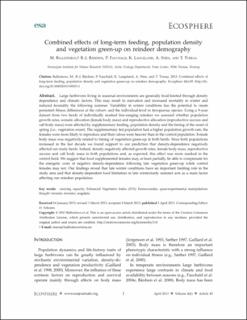| dc.contributor.author | Ballesteros, Manuel | |
| dc.contributor.author | Bårdsen, Bård-Jørgen | |
| dc.contributor.author | Fauchald, Per | |
| dc.contributor.author | Langeland, Knut | |
| dc.contributor.author | Stien, Audun | |
| dc.contributor.author | Tveraa, Torkild | |
| dc.date.accessioned | 2023-07-11T07:16:29Z | |
| dc.date.available | 2023-07-11T07:16:29Z | |
| dc.date.created | 2013-04-26T13:45:08Z | |
| dc.date.issued | 2013 | |
| dc.identifier.issn | 2150-8925 | |
| dc.identifier.uri | https://hdl.handle.net/11250/3077515 | |
| dc.description.abstract | Abstract. Large herbivores living in seasonal environments are generally food-limited through density dependence and climatic factors. This may result in starvation and increased mortality in winter and reduced fecundity the following summer. Variability in winter conditions has the potential to create persistent fitness differences at the cohort- and the individual-level in iteroparous species. Using a 9-year dataset from two herds of individually marked free-ranging reindeer we assessed whether population growth rates, somatic allocation (female body mass) and reproductive allocation (reproductive success and calf body mass) were affected by supplementary feeding, population density and the timing of the onset of spring (i.e., vegetation onset). The supplementary fed population had a higher population growth rate, the females were more likely to reproduce and their calves were heavier than in the control population. Female body mass was negatively related to timing of vegetation green-up in both herds. Since both populations increased in the last decade we found support to our prediction that density-dependence negatively affected our study herds. Indeed, density negatively affected growth rates, female body mass, reproductive success and calf body mass in both populations and, as expected, this effect was more marked in the control herd. We suggest that food supplemented females may, at least partially, be able to compensate for the energetic costs of negative density-dependence following late vegetation green-up while control females may not. Our findings reveal that late winter conditions have an important limiting role in the study area and that density-dependent food limitation in late winter/early summer acts as a main factor affecting our reindeer population. carrying capacity; Enhanced Vegetation Index (EVI); Fennoscandia; quasi-experimental manipulation; Rangifer tarandus tarandus; ungulate. | en_US |
| dc.description.abstract | Combined effects of long-term feeding, population density and vegetation green-up on reindeer demography | en_US |
| dc.language.iso | eng | en_US |
| dc.rights | Navngivelse 4.0 Internasjonal | * |
| dc.rights.uri | http://creativecommons.org/licenses/by/4.0/deed.no | * |
| dc.subject | carrying capacity | en_US |
| dc.subject | Enhanced Vegetation Index (EVI) | en_US |
| dc.subject | Fennoscandia | en_US |
| dc.subject | quasi-experimental manipulation | en_US |
| dc.subject | Rangifer tarandus tarandus | en_US |
| dc.subject | ungulate | en_US |
| dc.title | Combined effects of long-term feeding, population density and vegetation green-up on reindeer demography | en_US |
| dc.title.alternative | Combined effects of long-term feeding, population density and vegetation green-up on reindeer demography | en_US |
| dc.type | Peer reviewed | en_US |
| dc.type | Journal article | en_US |
| dc.description.version | publishedVersion | en_US |
| dc.rights.holder | © 2013 The Authors | en_US |
| dc.source.volume | 4 | en_US |
| dc.source.journal | Ecosphere | en_US |
| dc.source.issue | 4 | en_US |
| dc.identifier.doi | 10.1890/ES13-00015.1 | |
| dc.identifier.cristin | 1025784 | |
| dc.source.articlenumber | 45 | en_US |
| cristin.unitcode | 7511,4,0,0 | |
| cristin.unitname | Tromsø | |
| cristin.ispublished | true | |
| cristin.fulltext | original | |
| cristin.qualitycode | 1 | |

